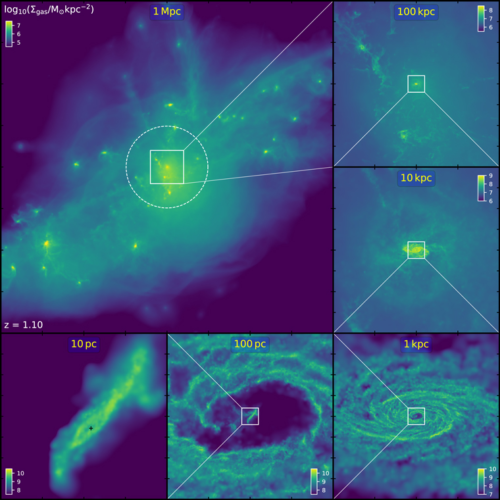How do supermassive black holes swallow up matter and help drive the galaxies of our universe? This fundamental question in astrophysics has yet to be fully answered, but it strikes at the heart of our creation and existence. Supermassive black holes, present in most galaxies, play a key role in galaxy evolution through their gravity, but nobody knows exactly how. In particular, the way these supermassive black holes accrete matter has been uncertain. For example, quasars—active galactic nuclei powered by supermassive black holes—are so powerful that they can outshine their entire host galaxies and be seen billions of light-years away. But how can so much gas accrete so rapidly as to sufficiently power these quasars?
Earlier this year, Daniel Anglés-Alcázar’s research group at the University of Connecticut made groundbreaking success in modeling black hole-galaxy interactions, finding a viable mechanism for black hole gas accretion and quasar luminosity. This model is unique in its use of novel mathematical techniques, dubbed “Lagrangian Hyper-refinement,” to accurately represent the flow of gas into a black hole on both small and large scales at once.
Spatial and Temporal Scales of Black Hole Simulations from simonsfoundation.org on Vimeo.
Animation illustrating the large range of spatial and temporal scales captured by the new simulations, with more than a thousand times better resolution than previously possible. Zooming in from the intergalactic medium on scales beyond one million light-years down to the inner ten light-year region of a massive galaxy, the predicted influx of gas into the accretion disk surrounding the supermassive black hole is high enough to power a luminous quasar at the epoch of peak activity. Credit: Anglés-Alcázar et al. Astrophysical Journal 2021.
Animation illustrating the large range of spatial and temporal scales captured by the new simulations, with more than a thousand times better resolution than previously possible. Zooming in from the intergalactic medium on scales beyond one million light-years down to the inner ten light-year region of a massive galaxy, the predicted influx of gas into the accretion disk surrounding the supermassive black hole is high enough to power a luminous quasar at the epoch of peak activity. Credit: Anglés-Alcázar et al. Astrophysical Journal 2021.
Previously, researchers had to make simplified guesses as to how black hole accretion would influence their galactic models, as the galactic models didn’t have the necessary resolution to incorporate existing black hole accretion models. This was a major limitation, considering how much the black holes’ mass could influence surrounding structures. But Anglés-Alcázar’s new model is able to do the equivalent of “adding more pixels to an image in the region where you want to zoom in,” he said, dynamically generating more gas circulation elements wherever the black hole is at any given moment to increase the resolution. Hence, even though the model begins on a multi-galactic scale, one can zoom in a million times at its center and see activity on the scale of only a few light-years.
The model’s results have been very promising. The presence of large asymmetries in galaxy shapes was found to be crucial to the accretion process. As a galaxy rotates, its asymmetrical parts, such as spiral arms, exert a constant gravitational pull on rotating gas. This makes the gas slow down, fall into smaller orbits, and eventually fall into the black hole. The model produced fractal-like generations of such spiral arms from the galaxy scale down to the accretion disk scale, supporting this theory’s application on all scales.
Most impressively, under some conditions, the inflow of gas into the black hole was found to be large enough to explain luminous quasars. In other words, gas was entering the black hole fast enough to account for the quasar’s energy output. “This was the first time that a single simulation covering the whole range of scales had been able to show that effect,” Anglés-Alcázar said.
When the researchers studied the few quasars near enough to the Earth to observe in detail, they obtained results that resembled the model’s. Additionally, the model shows that, surprisingly, even supermassive black holes can move substantially over time, and galaxies change their shapes by the interactions between their arms and migrating central black holes.
But an even bigger surprise was that the model, with certain starting conditions, also showed that galaxies often go into and out of active phases over time. Dormant supermassive black holes—such as our own galaxy’s Sagittarius A*, which doesn’t accrete much matter at the moment—can become active again after several million years by similar steps as described previously. The process, however, occurs at a much lower level, with galactic features slowing gas down and making it fall inward. These results greatly enhanced the team’s confidence in the model, as they not only matched known statistics on the frequency of dormant versus active black holes, but also showed that the model could cover two different situations despite being made for only one.
Anglés-Alcázar is very optimistic about his model’s future. “We can do these kinds of experiments on dwarf galaxies or on galaxies more like our own Milky Way, or the same galaxy but at an earlier phase, or even the very early universe, back when the first galaxies were forming,” he said. Anglés-Alcázar also wishes to make the model even more accurate by including the effects of black holes’ strong winds and relativistic jets.
The door is wide open to new discoveries. And each discovery is another crucial step towards understanding our world. “In order to understand galaxies, we have to first understand black holes,” Anglés-Alcázar said.

